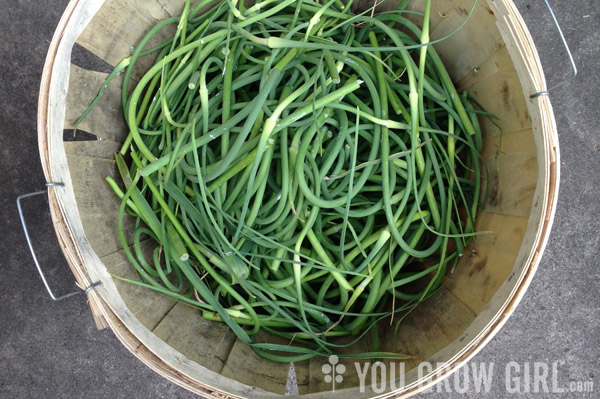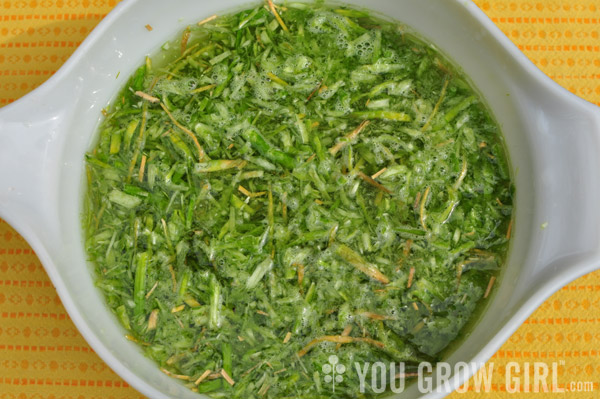
Although, all plant parts harvested from the garden ultimately serve a purpose by being recycled into compost and are never truly wasted, I am always looking for other applications that can extend their usage. Garlic scape (the edible, unopened blooms of the garlic plant) season is nearing its end in my garden and as the flower stalks develop on the plant I find that they become too tough and fibrous to eat, even after cooking.
To get one more life from the stalks, I add them to my stock pot along with onion scraps, vegetable ends, herb stalks, and leftover bones to make soup stocks that we can eat and enjoy. For the garden, I make sprays that can be used to deter some insect pests and diseases.
Note on Garlic Sprays: Before I get into how to make sprays, it’s important to explain that my use of garlic spray is both moderate and carefully considered. Through the years I have moved further and further away from sprays and rely almost exclusively on best growing practices and picking off pests with my hands. The vast majority of the sprays I make and use are about applying nutrition rather than killing insects or preventing diseases (an example would be nettle spray).
Garlic is organic and technically “safe,” but it is also powerful stuff. As a pest repellant it kills indiscriminately, harming beneficial insects along with pests. It can also burn the leaves of some sensitive plants. For these reasons I only use it in targeted, small quantities applied directly onto pests and I always do patch tests on plants before applying more widely. The great thing about using scape stalks to make sprays is that they tend not to be as potent as garlic cloves, making it somewhat safer for use on sensitive plants. I also find it helps to apply these sprays on overcast days, or in the evening or very early morning rather than in direct, hot sun.

Spray to Help Prevent Diseases
Garlic’s antifungal properties can be used to prevent diseases such as rust, blackspot on roses, powdery mildew, and gray mold aka botrytis.
Instructions:
Roughly chop rough garlic scape stems in a food processor. In the case of particularly tough stems, it helps to add a little water. Place the chopped plant material in a bucket or bowl and cover with cold water at a ratio of 1 part garlic scape to 2 parts water. Set out in the sun to steep for a couple of days. Agitate or stir a couple of times per day.
Strain and pour into a spray bottle. Spray directly onto leaves as instructed above. Toss the rotted garlic scape bits into the compost bin.
Spray for Soft-Bodied Insects
This recipe is most effective against soft-bodied insect pests such as aphids and some caterpillars. Please remember to investigate the insects in your garden and learn their identities before spraying indiscriminately.
You can find another recipe using garlic cloves over here…
Instructions:
Roughly chop tough garlic scape stems in a food processor. Pack the chopped plant material in a glass bowl or jar and cover with oil. I prefer olive or canola oil. Set aside to steep for a few days or up to about a week. Strain out the plant parts and pour the oil back into the jar.
To use: Dilute approximately 4 tablespoons to about a gallon of water and spray directly onto pests. You may need to make some adjustments depending on the potency of your scape stalks.
Another great idea, Gayla! Thanks for describing all the issues about spraying and for giving details about the dilution. Many times garlic is mentioned by gardeners as a base for a spray without any clarification or instructions, leaving the issue wide open for misinterpretation.
I also hand pick insect pests left and right. This week it is Japanese Beetles. Every week it is slugs. After seeing damage over and over, the squeamish aspect diminishes and courage builds.
I made your Cherry Clafoutis recipe a few days ago and got rave reviews. The pitting was a fun activity for my (recovering) husband to assist with in the kitchen. We did not forage for the cherries, I am sad to admit. This week’s grocery store trip yielded Canadian cherries for sale. Last week it was Oregon and Washington’s crops.
My Goldilox tomato plants grown from your seeds look happy and vigorous. They are certainly moist enough as we have had 5 weeks of regular rainfall. I have not harvested any tomatoes from my 8 varieties yet, but am seeing a lot of heavy green fruit. Keeping fingers crossed for Blight to stay away.
Good article. One thing I would point out is that a stronger spray has its place. Spray it on the soil and on paths to keep away larger pests such as cats. Spray it in a greenhouse either in the air or on the panels to keep it pest fee, spraying around the bottom also helps with woodlice/woodlouse which damage roots
I love ideas that suggest optimal usage of a certain plant, so thank you for this post, Gayla. I will definitely try your recipes.
I mean, yes, it’s easier in the short run to do everything the easy way and not to research on the matter. You just need to buy some kind of pesticide and spray it all around. But, in the long run, it’s always the best to optimize everything we have, and every process and effort we make. It’s always a good idea to try something organic.
And there’s nothing more logical than to use your own bare hands to remove pests from a plant. I’ve learned that with many trials and errors. There is no shortcut in doing a great job. But it can get hectic.
So, I guess, the golden middle of organic pesticide is the best.
lol. When I saw that lead picture I thought you were going to present us with a unique salad arrangement :-D
However, I wasn’t disappointed as I read on :-) But, rather than needing a spray can you just keep growing garlic and onion varieties in your garden to ward off those evil bugs. Of, course keeping the companion planting guidelines in the back of your mind.
I’d love a few tips on keeping the bugs off my Curly Leaf Kale, if you have any. Perhaps this spray is the best thing for kale?